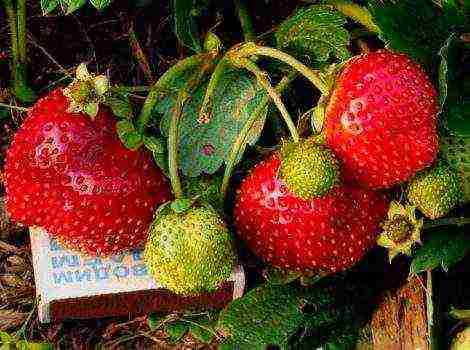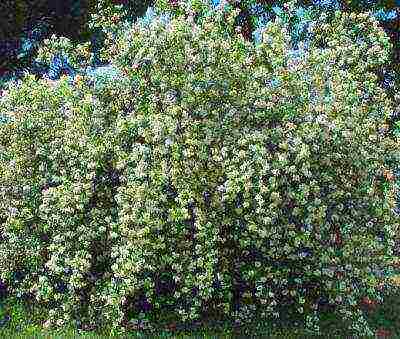Content
- 1 Variety of junipers
- 2 Juniper planting rules
- 3 Video
- 4 Juniper: species and varieties
- 4.1 Rocky junipers: varieties
- 4.2 Common juniper: varieties
- 4.3 Chinese juniper varieties
- 4.4 Juniper horizontal: varieties
- 4.5 Tall junipers: varieties
- 4.6 Fast growing junipers: varieties
- 4.7 Edible juniper: varieties
- 4.8 Juniper Cossack: varieties
- 4.9 Juniper: varieties for the Moscow region
- 4.10 Juniper varieties for Siberia
- 5 Varieties
- 6 Care Tips
- 7 Common juniper (Juniperus communis)
- 8 Juniper virginiana (Juniperus virginiana)
- 9 Juniper Cossack (Juniperus sabina)
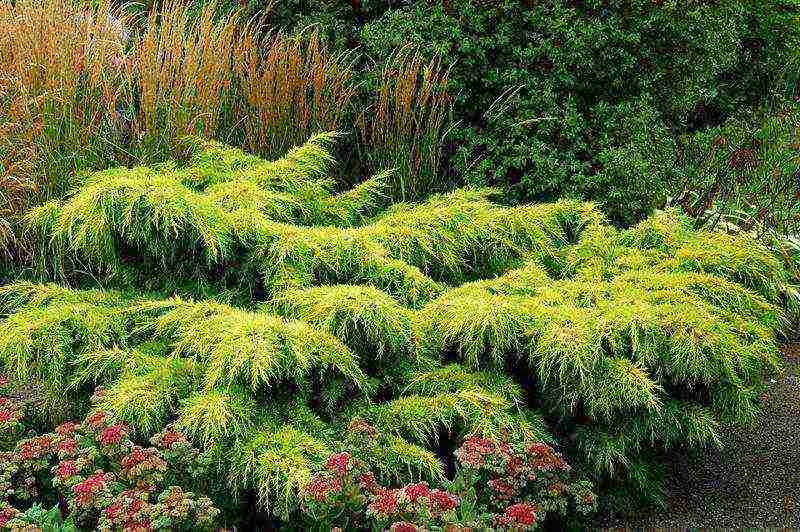
Evergreens have always attracted human attention with their durability and beauty. Juniper (Juniperus) occupies a special place among conifers, not only for its beauty, but also for its unique properties. The abundance of species and varieties of juniper allows you to choose a tree suitable for any purpose. And proper care, protection from diseases, pests, will allow you to enjoy its aroma and beauty for many years.
Variety of junipers
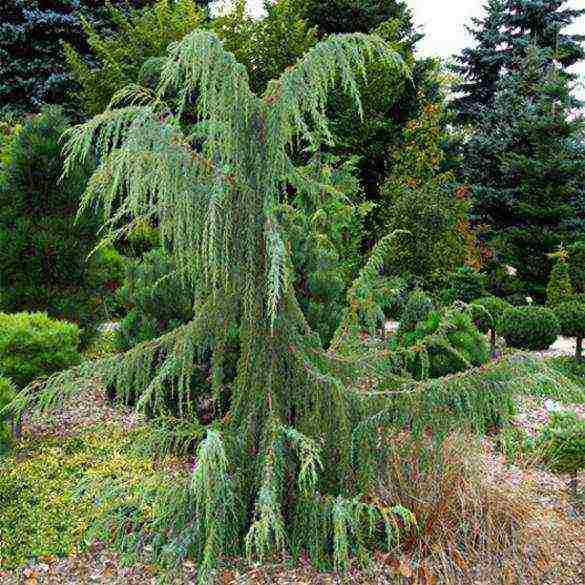
Weeping Juniper
Today there are about one hundred varieties of juniper, united by common specific features. Some of them arose as a result of natural mutations, some were created through the process of targeted selection.
In nature, there are about 70 species of juniper (juniperus), of which only 15 have been cultivated so far. The most common in landscape design are the following:
- common juniper;
- rocky;
- Virginia;
- Cossack;
- Chinese;
- average;
- scaly;
- horizontal.
Most species of juniper are frost-resistant, undemanding to living conditions, care, as well as a pleasant aroma of wood and needles, the severity of which, however, varies depending on the species. Trees with scaly needles smell stronger than those with needle needles.
The shape of the crown varies, although most species lend themselves to crown formation by pruning. Cone-shaped and pyramidal crown shapes are good in group plantings. Initially, four forms are distinguished:
- conical;
- pyramidal;
- weeping;
- creeping.
Also, juniper species are grouped according to several other principles, for example, winter hardiness, toxicity, unpretentiousness.
Representatives of the Cossack juniper are poisonous, virgin and rocky ones are distinguished by their unpretentiousness. Winter hardiness is characteristic of almost all species, with the exception of some less common, among which:
- inclined;
- Turkestan;
- Red;
- Zeravshan.
Due to the external beauty, some species can be attributed to a special group of decorative junipers, this refers to:
- ordinary;
- horizontal;
- medium;
- scaly junipers.
When choosing the type and variety of juniper for growing on your site, it is important to decide in advance on the purpose that it will fulfill. This will help you choose the right type of tree, based on its specific features.
Common juniper
Representatives of the common juniper species are highly resistant to adverse weather conditions - cold, frost, lack of water or light.The varieties belonging to the species juniperus communis are extremely decorative, and their slow growth allows them to be used for growing bonsai trees.
The following are considered popular varieties belonging to this species:
Gold cone
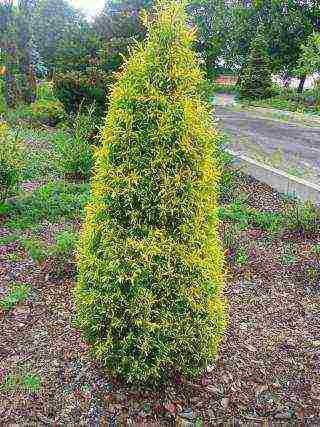
Juniper Gold Cone
Tall tree (up to 4 m tall) with a dense conical crown. Annual growth is about 10 cm in height, 5 cm in girth. It grows most actively in summer. With the beginning of autumn, the bright golden needles turn yellow-green, and by winter, the color turns to bronze. Not picky about the composition of the soil, but does not tolerate its compaction, excess moisture. It prefers to grow in sunny places, with a lack of light, the needles turn green. The first few years need additional care: watering, shelter from the direct sun, tying branches in winter.
Hibernika
Representatives of this variety of juniper can reach 3.5 m in height, 1 m in girth.
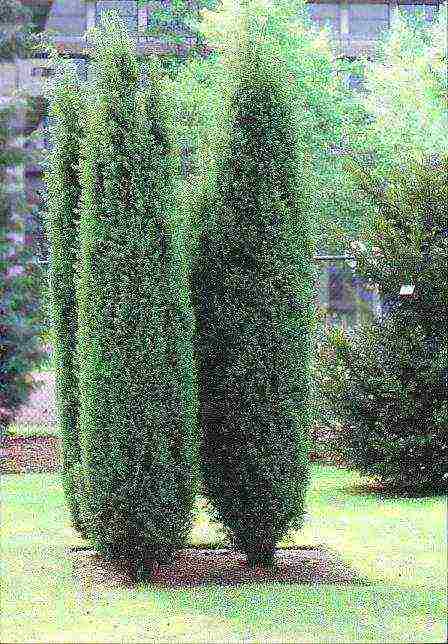
Juniper ordinary Нibernica
The shape of the crown is narrow-columnar, the annual increase in indicators is about 10 and 5 cm. The needles of the needles are rather soft, not prickly, the colors are green with a bluish tint. Hardy, prefers sunny places. It is not picky about the composition of the soil. In the spring, this juniper is recommended to be sheltered from the bright sun, and in the winter - to tie the branches to protect it from snow.
Green carpet
Unlike its counterparts, the common juniper of this variety is rather low - only 0.5 m in height, but it can reach one and a half meters in width. The annual growth is about 5/15 cm, respectively.
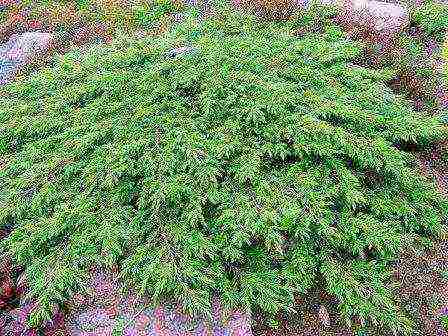
common juniper Green Carpet
The eye is pleased with the unusual shape of the crown - thick, ground cover. This variety is well suited for decorating slopes, growing in rocky gardens.
Suecica
Another variety with a columnar crown shape. In height and width it can reach 4/1 m. The approximate annual growth is 15 and 5 cm for each indicator. It is a fairly dense shrub with erect shoots. The needles on the branches are painted in a beautiful bluish-green hue.
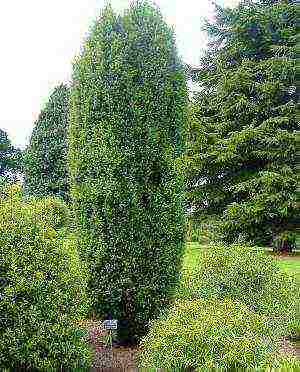
common juniper Suecica
The variety is frost-hardy, characterized by slow growth, unpretentiousness to growing conditions. Like other varieties, it prefers sunny places, with a lack of light, the crown loses its shape, becomes spreading. This shrub lends itself well to shaping and pruning, which allows it to be used for decorative purposes to create various landscape compositions.
Rocky
originally from mountainous regions. Very hardy, easily copes with drought, frost-hardy. Looks great in rocky gardens and alpine hills. The most decorative varieties of rocky juniper:
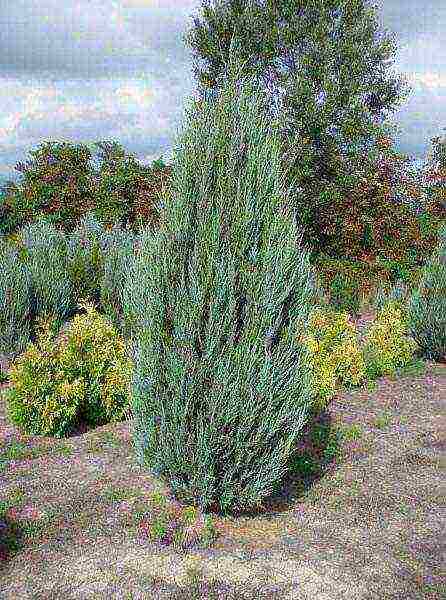
Rocky juniper Skayroket
Very tall trees, up to 7-8 meters in height. The crown shape is columnar, the width of an adult plant is 1 m. The annual growth rate is 15 and 5 cm, respectively. The shoots grow densely, the needles are soft and have a pleasant green color. In general, it is not picky about conditions, care, but grows poorly on too saline or waterlogged soils. Branches for the winter must be tied up to avoid damage.
Blue arrow
A tall juniper, up to 5 m in height, has a narrow columnar crown (up to 0.7 m in girth).

Juniper Blue Arrow
The annual growth is 10 and 5 cm. The crown is made up of dense, upright, rigid branches, decorated with scales of soft needles of a deep blue color. Prefers sunny places, loose soil, unpretentious to conditions, resistant to cold.
Virgin
Virginian juniper varieties are considered one of the least capricious and demanding in terms of care or keeping conditions. These trees grow safely on any soil, in any weather conditions. For its crown shape and wood quality, Virginia juniper is often called "pencil tree".
The varieties are especially decorative:
Gray owl
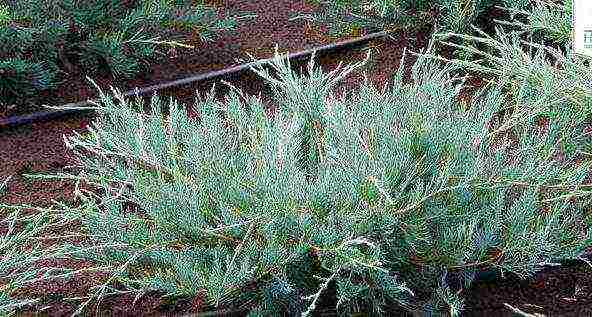
Gray owl
Sprawling low (up to 1.5 m in height) shrub. Dense wide crown of gray, silvery-green needles.The variety lends itself well to pruning, so the shape of the crown can be changed as needed. The width of an adult plant is approximately 2 m. The annual growth in height and width is about 10 and 15 cm, respectively. It categorically does not accept excess water in the soil, photophilous.
Burkii
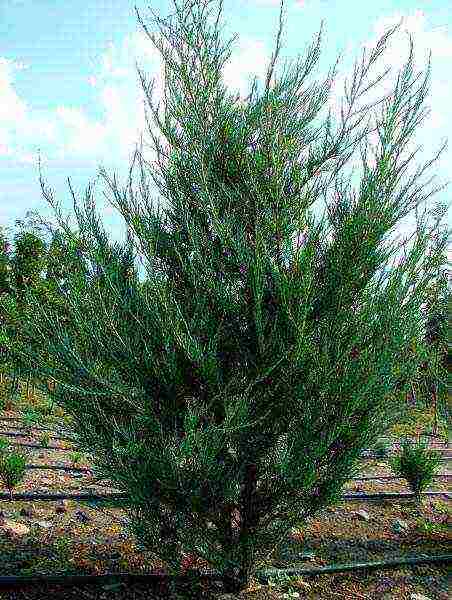
Burkii
Tall tree with soft greenish needles. The shape of the crown is pyramidal, it can reach a height of 3 m.
Glauca
One of the most famous varieties of Virginia juniper.
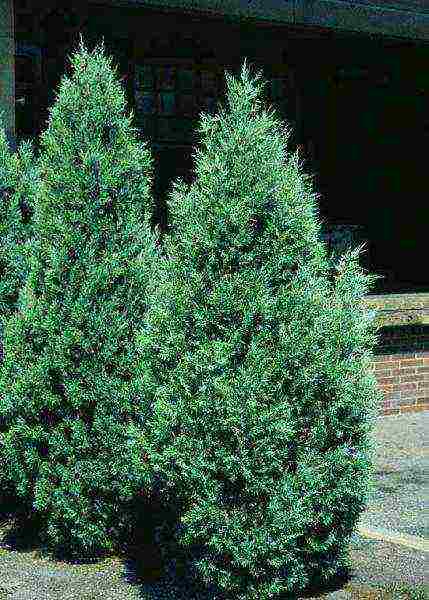
Glauca
Attracts attention with silvery-green needles, covering numerous shoots, forming a conical crown.
Canaertii
A fast growing juniper with a columnar crown and soft dark green needles.
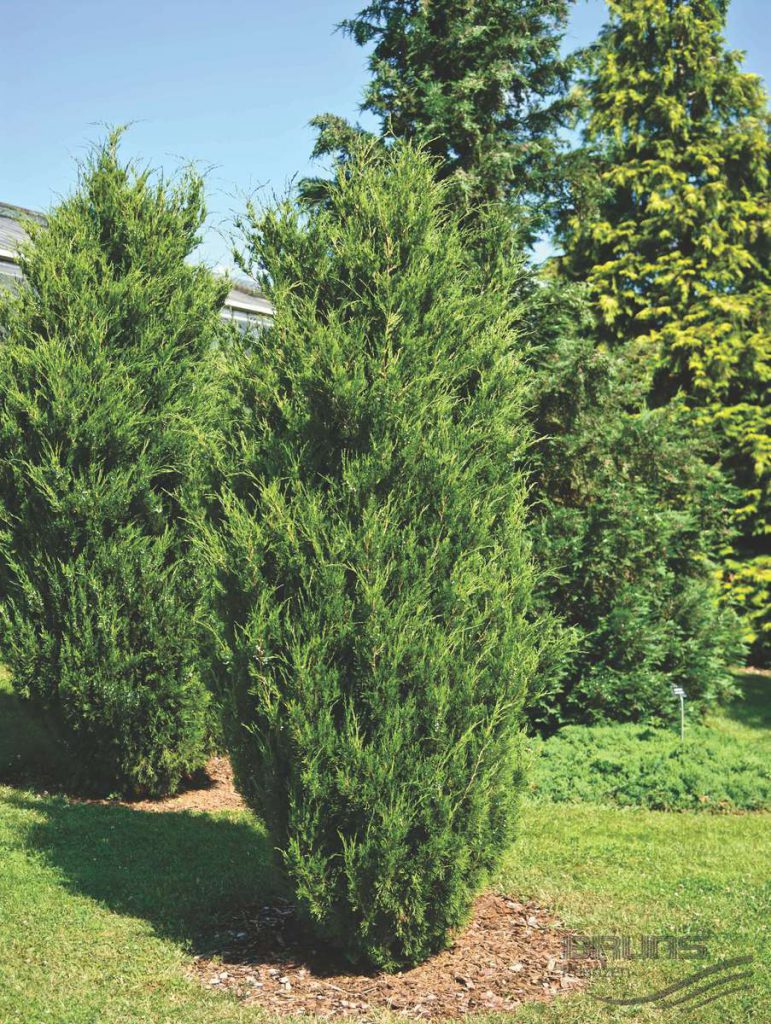
Canaertii
With the onset of autumn, the tree is decorated with small but numerous blue fruits.
Cossack
Along with numerous advantages, including undemanding growing conditions, resistance to adverse weather events, Cossack juniper has a serious disadvantage. Its shoots are extremely poisonous, as they contain sabinol - a toxic substance that can increase bleeding and has an abortive effect. Look good in group plantings, rocky gardens.
This species includes the following varieties:
Variegata
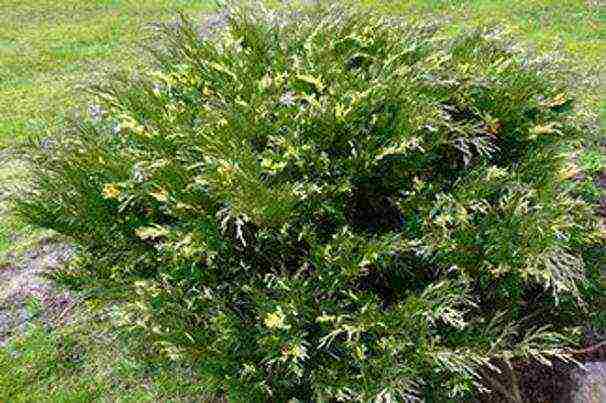
M. Cossack Variegata
A very beautiful shrub surprises with a combination of green and creamy shades of scaly needles on the branches. This variety of Cossack juniper does not tolerate excessive soil moisture, grows slowly, hardy, light-requiring.
Blue danube
Representatives of this variety are dense shrubs with creeping branches.
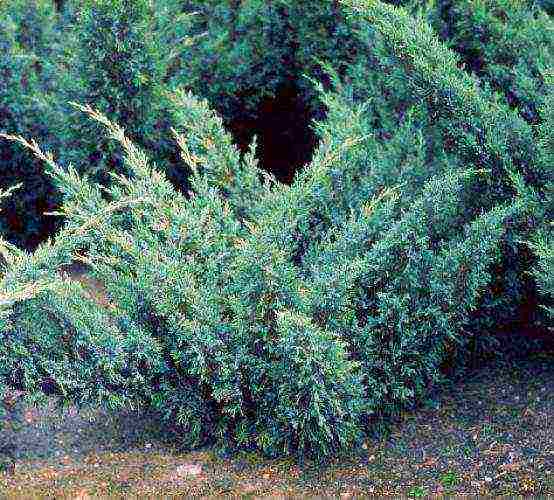
M. Cossack Blu Danube
The color of the scaly needles is green, by autumn it is replaced by a silvery-bluish tint.
Glauca
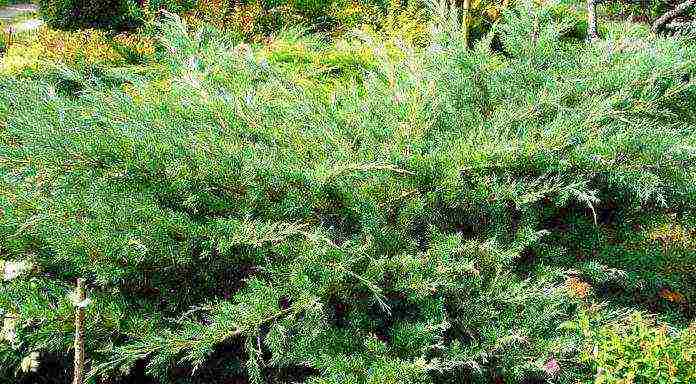
M. Cossack Glauca
A low, up to 1 meter in height, plant, surprising with an unexpected bronze shade, which its gray-blue needles acquire in winter. The width of an adult plant is up to 2 m, and the annual growth is 3 and 5 cm. Photophilous, prefers sunny places, and is not picky about other conditions.
Arcadia
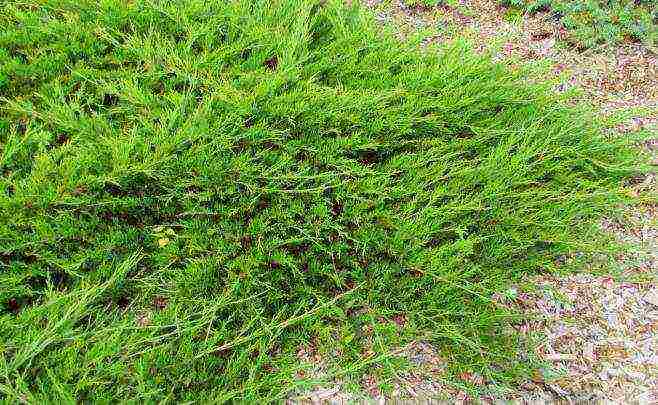
Arcadia
An unusual variety of Cossack juniper, growing like a carpet on the surface of the earth. The height and width of an adult plant reach 0.5 and 2.5 m, respectively, the growth is about 3/5 cm per year. The creeping shape of the crown makes it look like a fluffy green pillow of soft needles.
Chinese juniper
Most often, Chinese juniper is used to create bonsai trees, as they have a slow growth rate. Habitat - Japan, China, Korea.
The varieties of this type include:
Arcadia
A dwarf frost-resistant variety of Chinese juniper. It can reach a height of 2 m, the width of an adult plant is about 80 cm. The shape of the crown is conical. The needles are colored green with a blue tint. In landscape design, it is used as a bright accent for compositions, for single plantings or for the formation of a hedge.
Blaauw
A low (up to 1.5 m in height) shrub with an asymmetrical crown shape and brightly colored needles with a light blue tint.
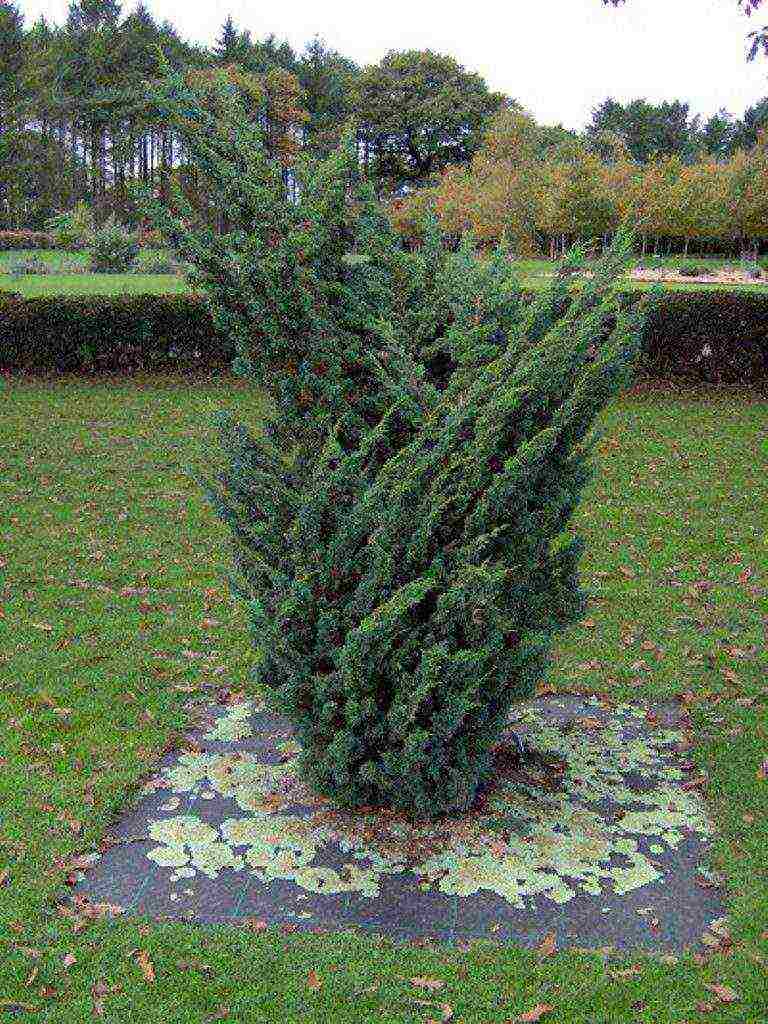
Juniper Chinese Blaauw
This variety of Chinese juniper has a slow growth rate.
Kuriwao gold
An ornamental variety of Chinese juniper, attracts attention with an asymmetric crown shape, a combination of dark and light areas of needles.
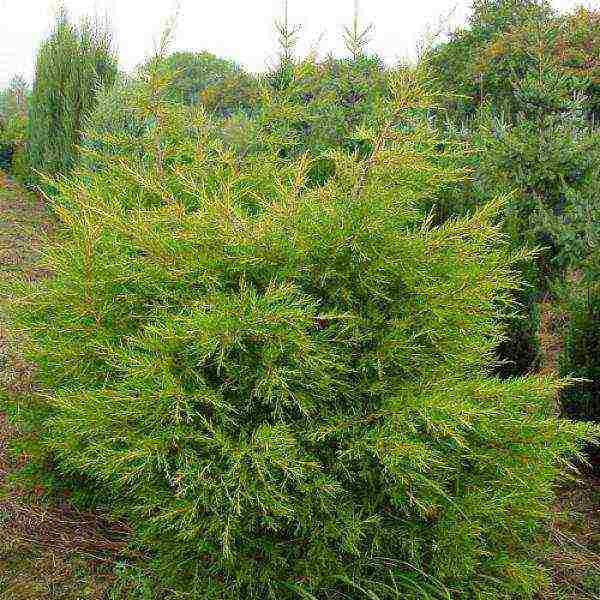
Juniper Chinese Kuriwao Gold
Prefers sunny places, as in the shade the needles lose their brightness. In landscape design, it is used in different ways, as it looks great in single, group plantings or rocky gardens.
Juniper medium
This species is a hybrid of common and Cossack junipers. He received the name Pfitzeriana. Inherited from them extreme resistance to adverse climatic conditions and improper care. Juniper average Pfitzeriana has a wide varietal variety. Its most popular varieties:
Old gold
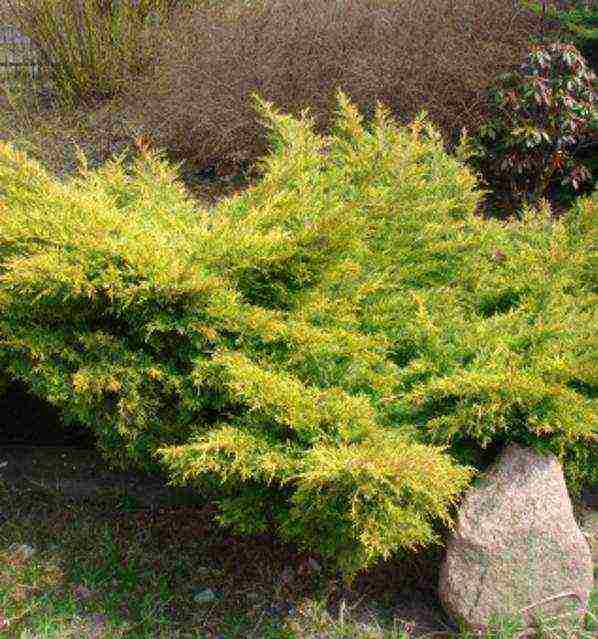
M. Medium Old Gold
A very beautiful decorative Dutch variety that attracts attention with its soft golden needles. It is a fairly compact shrub, reaching 2 m in width and only 1.5 m in height. In landscape design, it is used for decorating wells, creating hedges.
Gold star
This variety of Pfitzeriana juniper is rightfully called the garden's golden star.

Juniper Medium Gold Star
Its bright golden yellow needles immediately grab attention. This is a low, spreading shrub, reaching 1 and 2 m in height and width. It prefers to grow in a sunny place, since growth slows down in the shade. It tolerates frost well, can grow on any soil.
Mint Julep
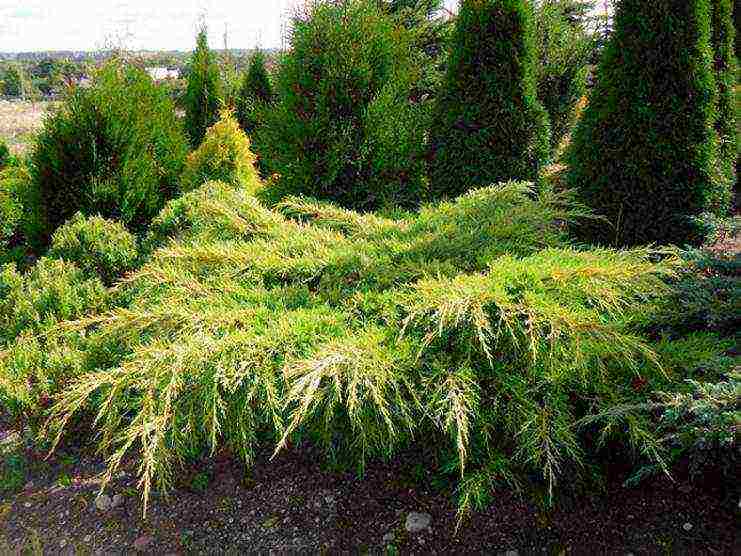
Mint Julep
Attractive low shrub with graceful arched branches forming a spreading crown. Scaly needles of bright green color effectively set off the gray berries, which gives this juniper variety a special decorative effect. Photophilous, used in group plantings to create alpine slides.
This species also includes the varieties Pfitzeriana Aureya, Pfitzeriana Glauka, etc.
Scaly junipers
The homeland of this species of junipers is the Himalayas and China. He, like other species, is extremely unpretentious to growing conditions, grows well on any type of soil, easily tolerates drought and severe frosts. The most decorative varieties of this type are the following:
Blue Carpet and Blue Swede
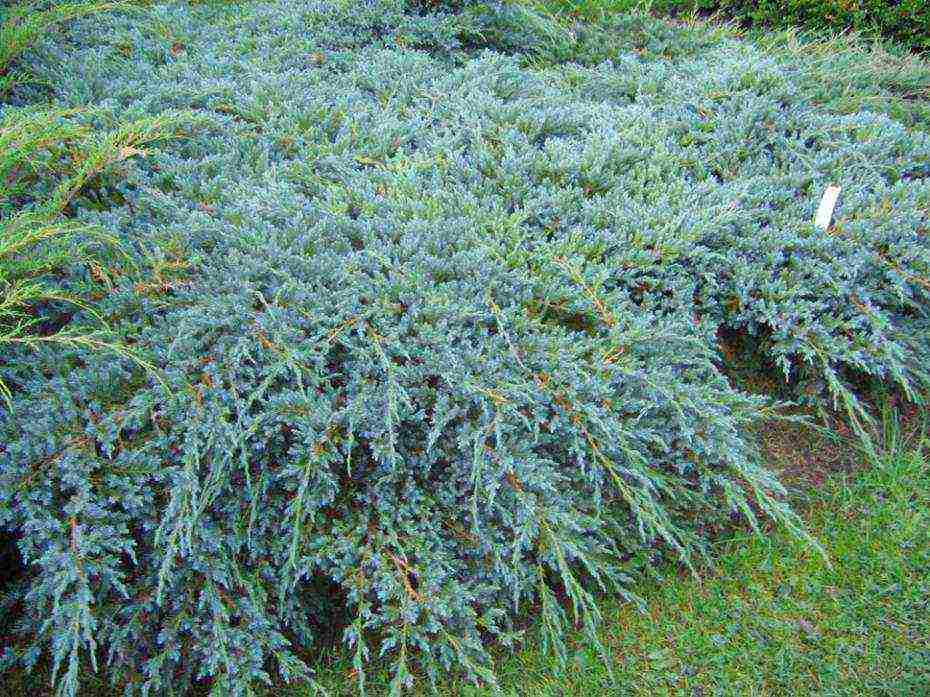
Quite similar varieties, united by a beautiful silver-blue shade of needles. These are sprawling, low shrubs that grow quickly and are used to strengthen the slopes.
They prefer sunny places, are easy to crown formation, frost-resistant.
Holger

Holger
The variety is very decorative due to the spectacular combination of green old needles and bright golden young needles. Spreading bush, wide.
Horizontal
Juniper horizontal refers to ground cover plants, most often used to decorate slopes and retaining walls. His homeland is North America. The following varieties belong to the type of horizontal juniper:
Blue star
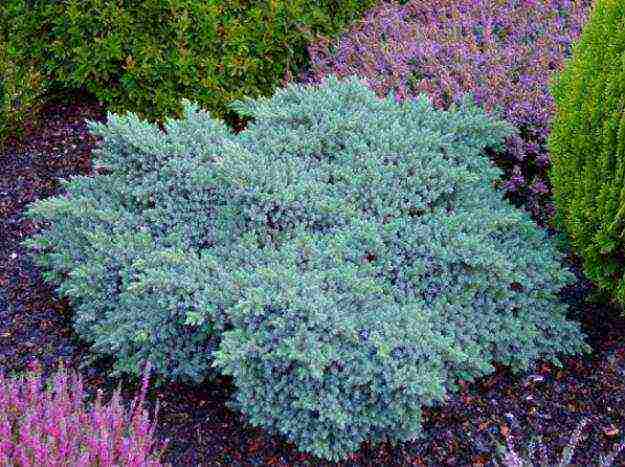
Blue star
A low-growing shrub, characterized by a blue color of needles with a slight steel sheen. He prefers acidic soils, tolerates well the effects of emissions and air pollution, and is frost-resistant.
Golden flame
Shrubs of this variety of horizontal juniper change their color with age. Adult needles are bright green, the needles on young shoots have a golden tint.
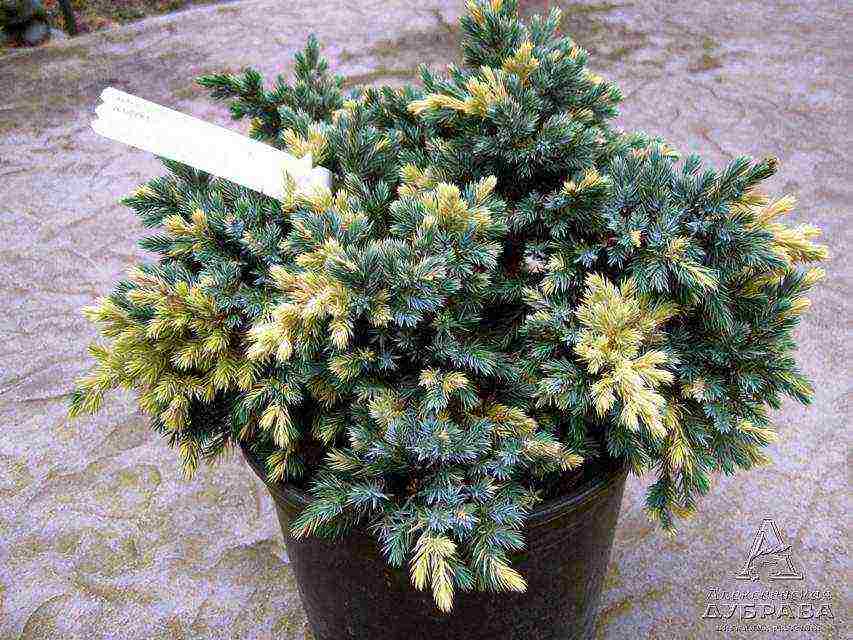
M. horizontal Golden Flame
He needs additional care - in the spring, dead needles are removed from the shoots of the bush, since he himself does not dump it.
Juniper planting rules
Despite the fact that the juniper is quite unpretentious, when planting it, you must follow some rules in order to get good results. As a rule, junipers are planted closer to mid-spring or September. If a seedling with a closed root ball was purchased, it is planted in a permanent place throughout the warm season.
When choosing a suitable landing site, several conditions should be considered:
- the juniper prefers to grow in well-lit places, it does not tolerate shading well;
- this plant should not be planted on waterlogged soils, near groundwater;
- some species need protection from wind and drafts;
- it is important to provide the plant with space, it does not tolerate tightness.
The first step in planting a seedling is to prepare the planting hole. Its size should be significantly larger than the root ball of the plant. It is also important to observe the optimal distance between seedlings (from 0.5 m for dwarf species to 2-3 meters for tall ones). At the same time, in group plantings or hedges, the distance may be less than the recommended one.
It is better to plant large species of junipers in light fertile soils, but dwarf varieties are more suitable for soil that does not contain many nutrients, otherwise they will lose their decorative effect.
At the bottom of the hole, a drainage layer must be laid out using expanded clay or broken brick. Then add the substrate and place the seedling. It is important to take care not to deepen the root collar. This will slow down growth and can cause plant disease. Ideally, the seedling is transplanted with an earthen clod to minimize possible root damage.
After disembarking, the pit is covered with earth and watered abundantly with settled warm water. Then the periostemal circle is mulched using any suitable materials.
Care, fertilization, wintering
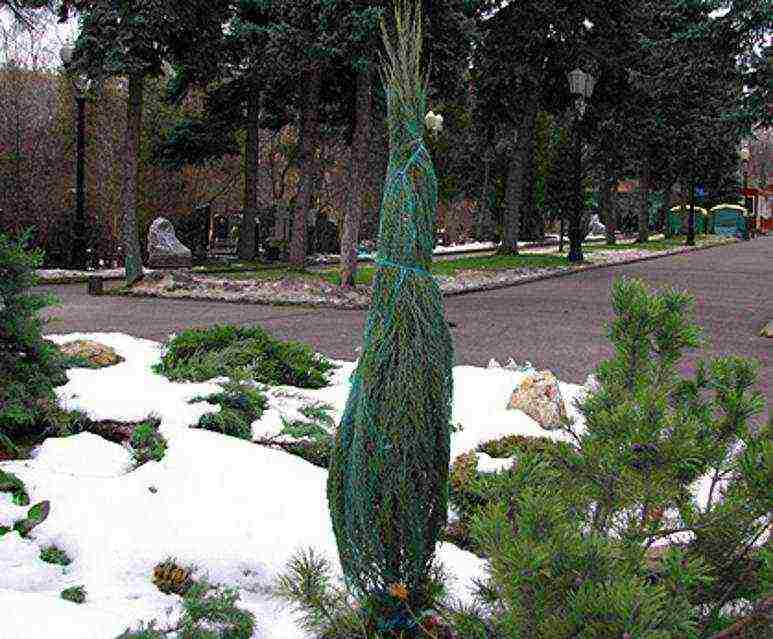
Preparing for winter
As already mentioned many times, junipers are completely not demanding to care for and grow well without outside interference. They need watering only during prolonged drought and in the first year after planting. Also, all types of juniper do not need fertilization, and for some it is even contraindicated.
Almost all types of juniper are frost-resistant, so they do not need a special shelter from the cold for the wintering period, except for the very first winter after planting, when the seedling is not yet strong enough. For young plants, spruce branches or any non-woven material are used as a shelter. In late winter and early spring, the juniper should be protected from bright sunlight, otherwise the needles on the shoots turn brown.
Trees with a conical and columnar crown shape need to be tied up with branches, as they can break under the weight of snow.
Diseases and pests
Like most other plants, juniper is susceptible to disease and pest attacks. The most common disease of this plant is rust.
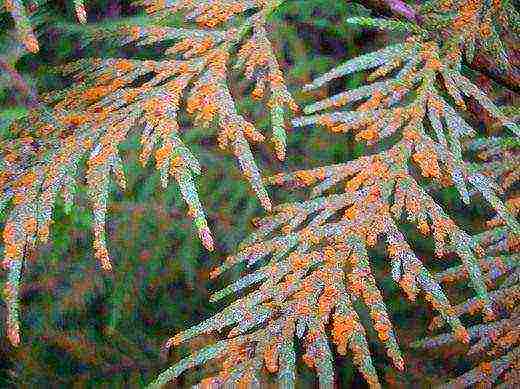
Rust (Mildew)
Its symptoms are orange growths on the branches and main trunk. As a rule, they appear at the very beginning of summer. This disease also affects fruit and ornamental plants, from which it can spread to junipers, so it is better not to plant them nearby.
To eliminate the disease, it is necessary to remove the affected parts of the plant, and then treat them with a fungicide. As a prophylaxis, it is recommended to use various immunostimulants.
If the juniper grows in conditions of high humidity and has been exposed to low temperatures, it becomes possible to develop another fungal disease - shute. Its symptoms are yellowing and browning of the needles, the appearance of black growths on needles at the end of summer. Most often, this disease affects plants growing in the shade. Control measures are similar to the previous ones.
Juniper can be attacked by several insects:
- Spider mite. It manifests itself in the cobweb entangling the shoots of the plant, and small yellow dots on the needles.
- Aphid. If these insects are found on the plant, it is necessary to process not only the juniper itself, but also the colony of ants that breed it.
- Shields. Their presence is noticeable to the naked eye - they are round or oval shields up to 2 mm in length. Symptoms of their appearance are drying and falling of needles, dying off of the tree bark.
For prophylaxis, juniper is recommended to be sprayed with immunostimulants and a weak solution of insecticides.
Juniper (Juniperus) is one of the most attractive conifers, not only due to its unpretentiousness and beauty, but also to the wonderful aroma of wood and needles. Subject to the simple rules of landing and caring for it, you can decorate the site for many years.
Video
Juniper is a beautiful, drought-resistant, light-loving, long-lived plant. More than seventy of its species are known. Many interesting varieties have been bred - juniper is grown both in the middle lane and in cold regions.
Juniper: species and varieties

Juniper varieties
The most famous are the following types and varieties of juniper.
• Common juniper - this species is highly frost-resistant. He is not picky about the composition of the soil. Ripening of berries takes 2 years.
• The middle juniper stands out against the background of other shrubs with an open crown shape. The plant is relatively winter-hardy - it needs shelter only in the first years of life.
• Juniper virginiana in height can reach 30 m. The plant prefers a dry steppe climate.
• The horizontal juniper is characterized by excellent adaptability - it feels good both in hot and cold climates.
• Daurian juniper is extremely unpretentious - it grows equally well both in the southeast of Siberia and in warm regions.
• Juniper Cossack - a prostrate or creeping bush. The plant is characterized by excellent winter hardiness. It is not afraid of droughts either.
• Chinese juniper is interesting for its decorative effect - even in nature, plants of the same species differ from each other in external characteristics. This allowed breeders to develop many interesting varieties.
• Reclining juniper is grown as a ground cover plant - a creeping shrub reaches a height of half a meter.
• Siberian juniper prefers mountain landscapes. It grows slowly, but it pleases with its beauty, it is not afraid of frosts and droughts.
• Rocky juniper is very decorative - even in natural conditions the plant has a beautiful crown. The color of the needles is also interesting - it has a bluish tint. The plant grows slowly, but it has a long life span.
• Scaly juniper attracts attention with its beautiful needles - they are painted in a gray-steel color.
Rocky junipers: varieties
Juniper of this species is represented by the following varieties: Blue Arrow, Globe, Repens, Pathfinder, Skyrocket, Silver King, Wichita.
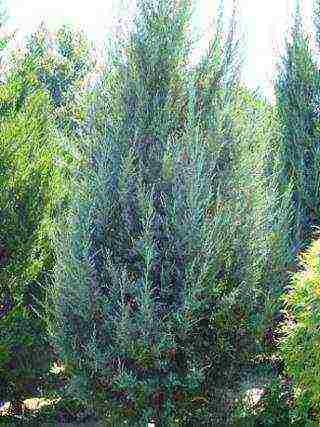
Juniper Blue Haven
The Blue Haven Juniper is a slow growing plant. Its maximum height is 2.5 m. The plant has a dense conical crown. The needles are colored light blue. The variety does not have high soil requirements.
Common juniper: varieties
Common juniper is represented by the following varieties: В 2, Columnaris, Сompressa, Echiniformis, Gold beach, Gold Cone, Green Carpet, Нibernica, Нornibrookii, Меуеr, Оblonga pendula, Repanda.
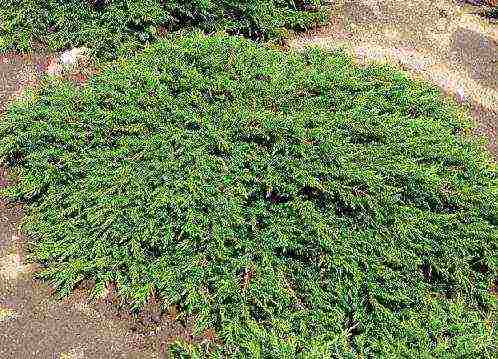
Juniper Green Carpet
The Green Carpet variety is a low juniper (even at the age of ten, the plant reaches only 10 cm in height). This variety is ideal for lawns - the plants do not need any trimming or special care.
Chinese juniper varieties
This plant species is represented by the following varieties: Blue Alps, Columnaris, Columnaris glauca, Echiniformis, Expansa, Globosa, Netzii, Mint Julep, Old Gold, Pfitzeriana.
Kurowavo Gold is a variety famous for its beauty. The plant forms a spherical crown. Its maximum height is 2 m. The needles differ in color - the young one has an emerald hue, and the old one is dark green.
Juniper horizontal: varieties
Creeping juniper (horizontal) is represented by the following varieties: Аdpressa, Аlpina, Аndorra compact, Аrgentea, Glacier, Glenmore, Petraea, Prostrata, Wiltonii.
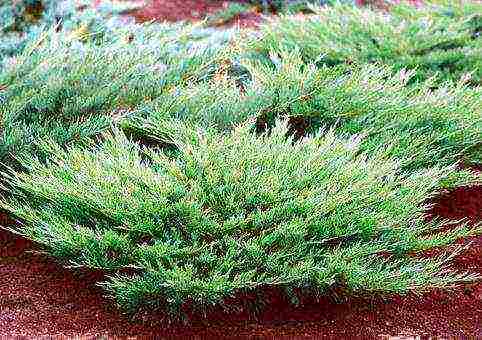
Juniper Andorra Compact
Andorra Compact - this variety is interesting in the shape of the crown (it resembles a fluffy pillow). In winter, the needles change color and turn purple-violet.
Tall junipers: varieties
Tall junipers are represented by different species. Accordingly, you can pick up a lot of varieties with optimal visual characteristics. The most interesting varieties: Skyrocket, Glauka, Gray Oul (Virginian juniper), Hibernika, Columnaris (common juniper).
Fast growing junipers: varieties
Good growth rates are inherent in the following varieties: Blue carpet (scaly juniper), Tamariscifolia and Mas (Cossack juniper), Pfitzeriana Aurea, Mordigan Gold, Pfitzeriana compacta (medium juniper). Virginia juniper is also growing rapidly.
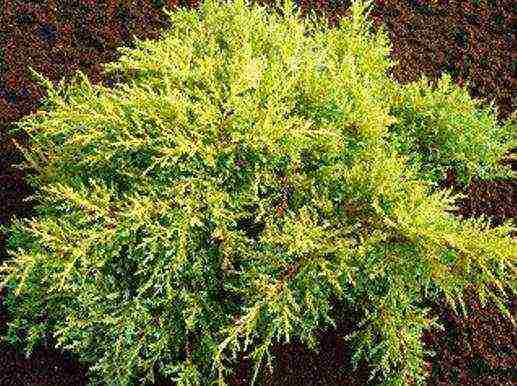
Juniper Mordigan Gold
Mordigan Gold is a graceful, compact, frost and drought tolerant variety. The needles have a golden hue. The plants reach a height of one meter, the crown diameter does not exceed two meters. This juniper tolerates urban conditions well.
Edible juniper: varieties
Juniper fruits are not eaten, like ordinary berries, but they are used in the preparation of tinctures, marmalades, kvass, jelly, jelly, beer.The aroma of the juniper makes the smoked meats especially tasty. Cossack juniper is poisonous. Fruits of other types can be used. The fruits of the Caucasian juniper are most widely used.
Juniper Cossack: varieties
Cossack juniper is represented by the varieties Аrcaida, Blue danube, Вuffalo, Сupressifolia, Еrecta, Fastigiata, Mas, Rockery Gem, Tamariscifolia.
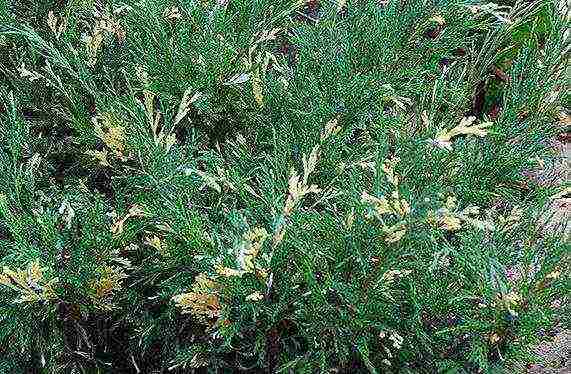
Juniper variegata
Variegata is a variety that has bright variegated needles (it is painted in a green-white or yellowish tint). This juniper grows slowly and forms a creeping crown. The highest height is 1 m. The plant is quite demanding on the composition of the soil. It does not tolerate frost and drought well.
Juniper: varieties for the Moscow region
Many types of juniper are grown in the Moscow region and central Russia. The most widespread are common junipers, horizontal, rocky, Cossack.
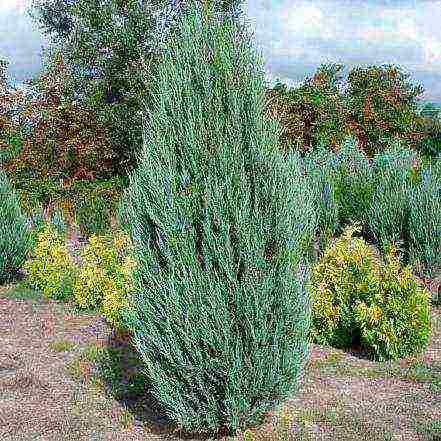
Juniper Skyrocket
Plants of the Skyrocket variety look very beautiful. They have a columnar shape. Scaly or needle-like needles are colored blue-gray. Plant height reaches 6-8 m. Unlike many other types of juniper, this variety grows very quickly - the annual growth is about 20 cm.
Juniper varieties for Siberia
Many junipers are characterized by good frost resistance, which allows them to be grown in harsh climatic conditions. The most widespread in Siberia and the Urals are Siberian junipers, Cossack, hard, Chinese, Virginia, ordinary, scaly.
Juniper Blue Alps
The Blue Alps variety (Chinese juniper) has excellent recommendations. The plant tolerates frost well, has a compact shape. Its average height is 2.5-4 m. The needle-shaped needles are colored silver from below, from above they are light green.
Juniper varieties are diverse. Plants are actively used for landscaping areas - they are very decorative, therefore they are in great demand.
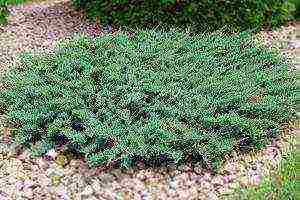
Recently, it has become very fashionable to create healthy beauty in their homes. Beauty that not only pleases the eye all year round, but also has a positive effect on the health of the human body.
And since the essential oils that the juniper exudes into the air have bactericidal properties, this gives it great advantages among other plant options for design and interior decoration.
Most often, horizontal juniper is used in landscape design. (By the way, read this article about the peculiarities of using junipers in landscape design).
Varieties
The horizontal juniper has a large number of varieties, the most popular of which are:
- Blue chip;
- Wiltoni;
- Lime Glow;
- Prince of Wales;
- Akari;
- Sargent.
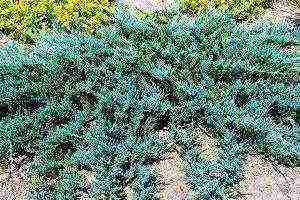 Juniper Blue Chip. For those who have decided to leave a long memory of themselves, then this is a good choice of the type of undersized junipers. The life span of this species is two hundred years. Therefore, when planting a Blue chip, you should think over everything.
Juniper Blue Chip. For those who have decided to leave a long memory of themselves, then this is a good choice of the type of undersized junipers. The life span of this species is two hundred years. Therefore, when planting a Blue chip, you should think over everything.
Like any long-liver, it grows for a long time, but confidently. It increases in length by five to ten centimeters per year.
The maximum length of its crown is up to two meters. Since its root system is equal to the length of its crown, this distance should be taken into account when planting surrounding trees or shrubs.
Blue Chip is a bluish color, very often used for border planting, due to its natural beauty. The mature plant takes on the shape of a star. It tolerates frost perfectly.
You may be interested in an article about
how to plant a juniper
.
Read the article on Andorra Variegata and Andorra Compact horizontal junipers here.
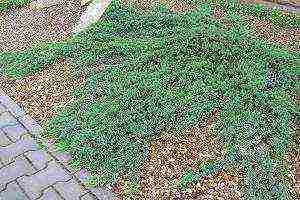
Juniper Wiltoni. The low-growing Wiltoni juniper is not tall and has the properties of "crawling in different directions". Its branches can grow up to one meter long.
The height of the shrub reaches twenty centimeters, and if you cut the length of its branches, the branches acquire a kind of "curliness".
Wiltoni's ground cover juniper will look good on cascades or alpine slides, it perfectly follows the curves of the surface. In winter, under the influence of winter cold, it acquires a lilac hue.
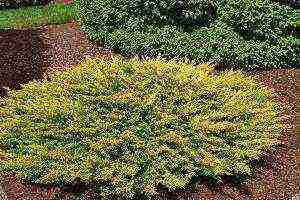 Juniper Lime Glow. Limeglow juniper is a slow growing shrub with incredible coloration that will delight the eye all year round.
Juniper Lime Glow. Limeglow juniper is a slow growing shrub with incredible coloration that will delight the eye all year round.
Its maximum height can be twenty-five centimeters, and the length of the spreading crown can be up to 1.5 meters in diameter.
It grows five to eight centimeters a year. Juniper Lime Glo is a completely poisonous plant. His palette will never cease to amaze you. During the year, the crown of the Limeglow variety changes from yellow to orange-bronze.
Specialist's note: pruning Lime Glow junipers is not recommended, so as not to cause unwanted diseases.
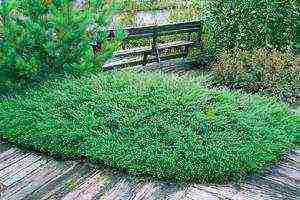 Juniper Prince of Wales. The Prince of Wales horizontal juniper fully justifies its name; it looks majestic and noble in the garden.
Juniper Prince of Wales. The Prince of Wales horizontal juniper fully justifies its name; it looks majestic and noble in the garden.
The shrub is green in color with a barely noticeable bluish tinge. It grows very quickly in comparison with other varieties of juniper.
The branches can be up to 1.5 meters long. On alpine slides, rockeries or other cascading landings, he will look like a real "prince surrounded by retinue".
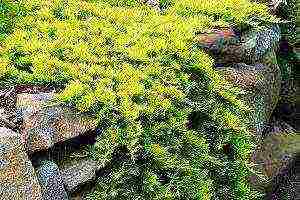 Juniper Akari. The Akari juniper is not inferior in beauty to other varieties of horizontal juniper.
Juniper Akari. The Akari juniper is not inferior in beauty to other varieties of horizontal juniper.
Its leaves are golden in summer and bronze in winter. Its bright palette will delight the eye both in warm summers and cold winters.
A groundcover, slow-growing shrub, will be a real highlight of any garden.
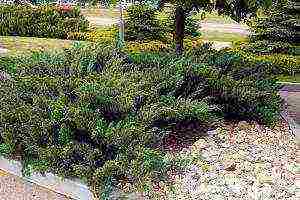 Juniper Sargent. The Sargent juniper is no less unique in its kind. This species was included in the Red Book of Russia.
Juniper Sargent. The Sargent juniper is no less unique in its kind. This species was included in the Red Book of Russia.
The height of the shrub can reach one meter, and the diameter of its crown can be up to three meters.
Due to the fact that the native element of its habitat is a rocky area or coastline, it perfectly tolerates Russian frosts. And the hot rays of the sun do not care for him. In this case, do not forget to water the juniper.
You may also be interested in the article on varieties.
rock juniper
.
Read an interesting article about the varieties of common juniper here.
Care Tips
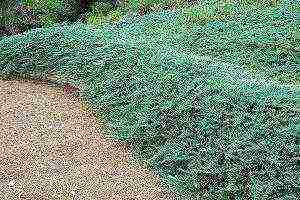 Horizontal juniper is a rather unpretentious plant. But, like any other plant, it has certain requirements: it loves moderate moisture and light.
Horizontal juniper is a rather unpretentious plant. But, like any other plant, it has certain requirements: it loves moderate moisture and light.
At the same time, in a semi-shaded place, he can also feel very good. In dry periods of the year, the juniper needs sprinkling of its crown - this helps the shrub maintain its color and thereby protects the branches from drying out.
In winter, of course, it is advisable to cover it with an awning so that the discharged winter sun does not burn the leaves, and the frost does not completely destroy the shrub. When planting a juniper, it is necessary to take into account its origin and the requirements of each species. Also, do not forget, like any shrub, juniper, needs to be treated from any pests.
Watch a video in which a specialist explains the features of growing a horizontal juniper of the Blue Chip variety:
Rate the article
(
estimates, average:
out of 5)
Juniper is known for its rich variety of species. Some plants are so different from each other that doubt creeps in about their belonging to the same genus. We suggest paying attention to the most popular juniper varieties.
Juniper is the most winter-hardy representative of conifers, therefore it is ideal for growing in regions with an unstable climate. Most often, in summer cottages, you can find common junipers, Virginia and Cossack junipers. They grow well without much care and take root easily, therefore they are popular among novice gardeners.Let's take a closer look at these junipers and their best varieties.
Common juniper (Juniperus communis)
This coniferous plant grows well both in the sun and in the shade. It is resistant to drought and frost, easily adapts to all types of soil, although it prefers sand and limestone.
Common juniper looks great both in single and in group plantings. It is often grown alongside roses, heathers, erika and flowering shrubs.
| Depressa Aurea | |
|
This juniper grows to a height of only 40 cm, but its diameter is 1.5-2 m. Short shoots sticking upward with golden yellow needles, which darken in autumn and turn bronze in winter, are very attractive. The plant looks as impressive as possible when grown in a lighted place: in the shade, the needles lose their brightness, the crown looses. |
|
| Meyer | |
|
This unpretentious shrub with a wide columnar crown and slightly hanging ends of vertical shoots grows quickly and tolerates a haircut, therefore it is ideal for creating attractive compositions with conifers. Plant height - up to 4 m, crown diameter - 1.5 m. The needles are attractive with an unusual color: they are bluish-gray with a silvery tint. For the winter, juniper shoots are recommended to be tied with a rope so that they do not break off under the weight of the snow. |
|
| Green Carpet | |
|
This sprawling juniper, up to 1 m high and 1.8 m wide, grows quickly and does not need careful maintenance. It has short, dense, thorny needles of an emerald green color. The shoots of the plant are first directed to the sides and up, then lie horizontally, and the ends of the branches go down. When grown in shady places, the color of the needles becomes less contrasting. |
|
Juniper virginiana (Juniperus virginiana)
This tree up to 2.5 m high tolerates formative pruning, although it is not recommended to cut many junipers, as they may slow down the growth of shoots. Therefore, it is the Virginia juniper that is ideal for growing as a hedge and topiary. In group plantings, it looks good in the vicinity of acacia, birch and other conifers: larch, pine, cypress, thuja.
The plant tolerates drought and shade well, is not very demanding on the composition of the soil, is not afraid of frost.
| Scyrocket | |
|
Dense columnar shrub with a height of 5 to 8 m and a width of 0.5 to 1 m. The needles are scaly, gray-green, bluish-green or silvery-gray, short and sharp. In autumn, blue-gray cones appear on the branches. The plant prefers sunny areas without stagnant water (in other conditions it grows poorly and loses its attractiveness), but it tolerates drought well and does not need additional watering. |
|
| Hetz Variegata | |
|
An adult plant reaches a height of 3-4 m, the crown diameter is 4-6 m. The crown is spreading, squat, shoots first grow horizontally, and then fall down. This juniper variety has gained wide popularity due to its attractive needles: they are scaly, bluish-green with creamy yellow dots. At the same time, it does not fade under the rays of the aggressive spring sun. When grown in the shade, the color of the needles becomes pale. In hot summer, it is recommended to water the plant 2-3 times per season. |
|
Juniper Cossack (Juniperus sabina)
This juniper is found in our gardens more often than others. The height of the shrub is up to 1.5 m. When rubbed in the palms of its needles, it exudes a pungent odor.
The cones of the Cossack juniper are inedible.
Juniper Cossack branches are often spread over the ground. They quickly take root in the soil, so the plant rapidly spreads to the sides and forms dense thickets (up to 20 m long).
This juniper is also undemanding to the composition of the soil, it tolerates drought, gusty wind and frost, it can grow in the shade, but it looks more beautiful in the sun. Recommended for growing in small backyard gardens and rock gardens.
| Tamariscifolia, or Tamaris | |
|
This juniper grows slowly and at the age of 10 it reaches no more than 30 cm in height with a diameter of 1.5-2 m. The needles are in the form of short needles of light green or bluish green color. During prolonged rains, the plant is susceptible to fungal diseases. |
|
| Glauca | |
|
This low shrub with a spreading crown grows rapidly in breadth. Its bluish-green needles acquire a beautiful bronze hue in winter. Against the background of spectacular needles, brown-black cones with a gray waxy bloom look great. Juniper is unpretentious and does not need maintenance, but it does not tolerate stagnant water and high salt content in the soil. |
|
We told you about the most popular types and varieties of juniper that are most often used in landscape design. But this does not mean that other forms in our latitudes take root badly. With minimal maintenance, the garden can be decorated with junipers of any varieties.
